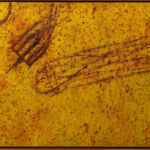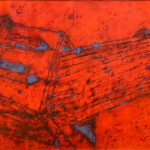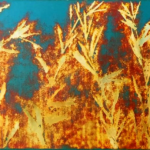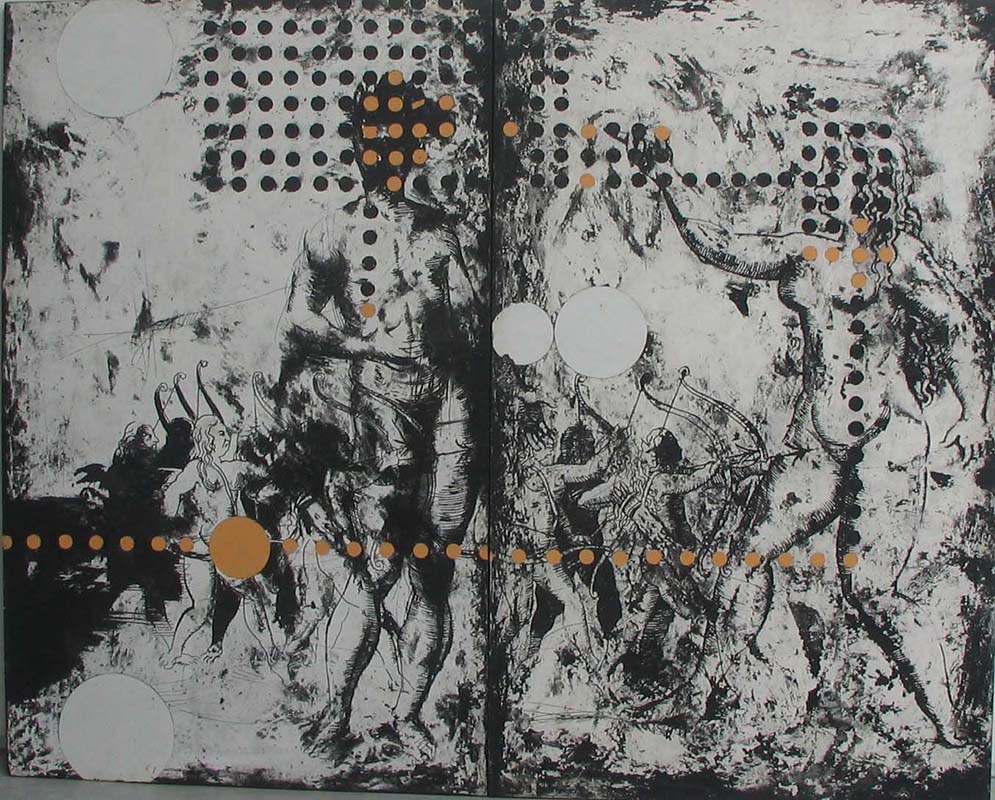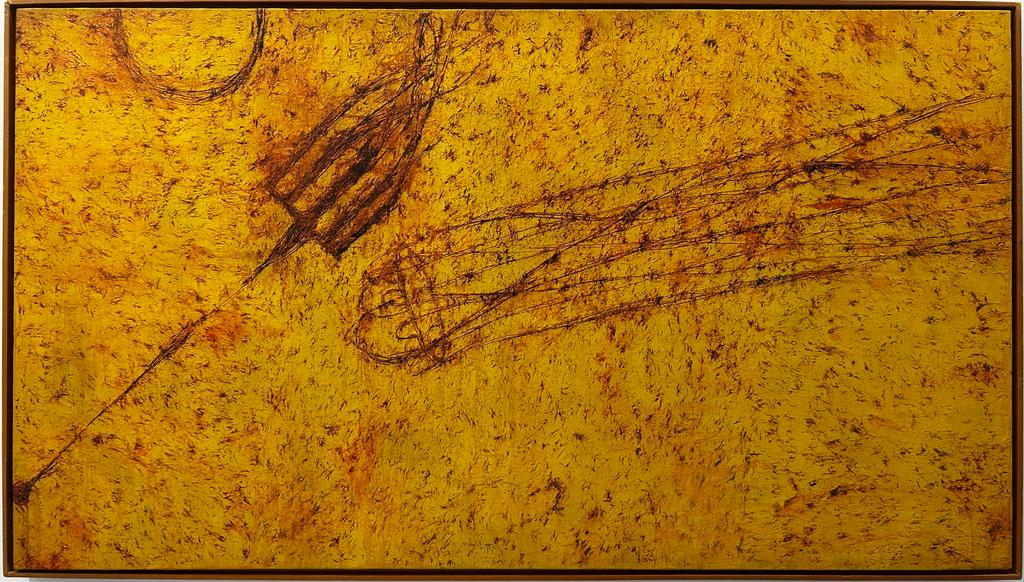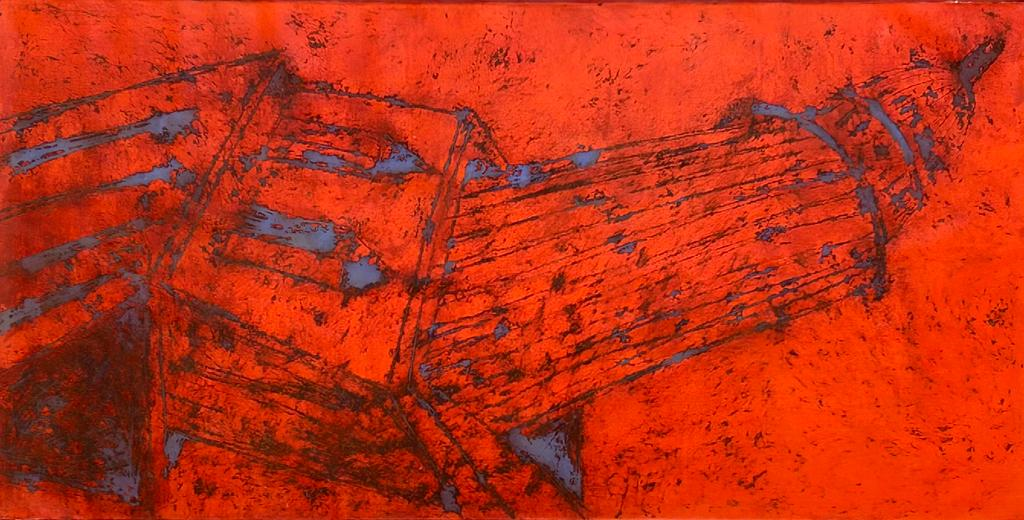The beginning of his artistic career is marked by the urban intervention, performing paintings in public spaces in Salvador. Currently, his work doesn’t prioritize a support or a technique; he works with video, painting, tridimensional works, multimedia installation and digital photography, performance. Your work has reflected the relations between body and identity, memory and belonging, making these some of the main axes of his research in art. Caetano Dias reiterates the way of Caetano Dias – of a painting essentially of color over color, in addition to brushstroke, now well marked, incisive, that vibrates in the search of an art that removes from the its own color the raw landscape of the surface without accessories, without ornaments, in a creation ever more essential, not only by the full mastery of his technique, but by an instigating beauty extracted from his own reality. It is a corporeal painting, painting that exists by his own act of creation, now performed together with multiple media, where they insert or integrate marks and, with this, expose his creative attitude before creating and recreating, making the spectator responsible for deciding what to visualize, as long as they know how to look, or understand, the construction of this language. He is considered by the national criticism as one of the most important artists who appeared lately in Bahia.
He was born in Feira de Santana, Bahia, in 1959. He lives and works in Salvador, Bahia. He started to exhibit individually as of 1989. He has participated in important exhibitions, representing Bahia and Brazil, such as the 18th Festival of La Peinture (France), The Brazilian Northeast Festival Contemporary Art (Portugal), International Art Fair (United States). Among individual and collective exhibits, he performed exhibitions in Brazil – Salvador, São Paulo, Rio de Janeiro, Olinda, João Pessoa, Belém, Brasília, Feira de Santana, Recife, Santos, São Félix, Curitiba –, and abroad – New York (Neuhoff Galery), Paris (Galerie Vivendi), Havana (Casa de las Américas). His work was awarded in the 16th Festival de Arte Contemporânea Sesc/Videobrasil (2007) with residency in Le Fresnoy, in Tourcoing, France.
Your painting always embodied color, through the insertion of grooves and entrails over the space of the canvas, forming a suggestion of images – fossils, plants, etc. Does your painting remain on this pathway?
Not only the painting, but everything I have been producing. Video and photography, in a certain way, go through the same issues of color and residual images; what you call fossils, I rather call residual images, they are fossils of the present. They continue to appear, yes, in painting, but they have mainly appeared in photos, videos and installations, such as the “Casa de Cupim”, in which I transform a termite nest in a fossil of a human house, or a fossil of architecture. Or even delivering important books to humanity, so termites rewrite them.
Another characteristic in your painting is that it has always placed color over color, a surface without ornaments, with the texture of the matter. Does this process continue?
My process is absolutely dynamic and procedural, I can’t affirm if I maintain the same creation process. By the fact of it being dynamic and always exchanging information, my process goes through constant changes, in a type of instability, which potentializes creation. I always thought, and I keep thinking, that it is important to reach to the bone of things so the poetry happens – in the bone of the idea, theme, color, etc. Anyway, reaching the essential points, so that poetry can be given in a clearer form, more transparent, since the works I’ve been doing are not that concerned with formal issues, but rather issues related to the concept, even if apparently they are treating the form. It is the form through the concept. What I do is a kind of prospection, in the case of painting, the prospection is of the color, creating a sort of skin, that is, a sensitive body, where color appears as something organic, or a simulation of this. In the overlaying of layers, when I make grooves – like tears on the skin -, I’m proposing this possible pictorial body, which, in a certain manner, bleeds continuously. In this sense, what I try to reach is a painting that, in a certain manner, is alive, pulses, like if this blood flew continuously. Then, the chromatic overexposure occurs like an atempt of an organic and pulsing painting.
Still about color, your painting has light, ochre, beige tones, even red tones. Is this procedure maintained? What led you to identify yourself with these tones and these colors?
I don’t know exactly why, but, in the beginning, painting was quite colorful, and maybe someday it goes back to it. I was always interested in monochromatic – or almost – works. On the other hand, I recall that my childhood living in Lapão, in the corn and cotton crops, huge and monochromatic fields. Or in the barns where the harvests are stored, those huge “pools” I used to climb up the laste bale and watch this huge accumulation of organic matter as if it was a painting, in the case of cotton, and sometimes I would dive in them, literally. Also, in more recent memories, from when I worked in a copper factory, the tones and colors I saw are present until today. I remember now of the cauldrons of melted copper spilling out and being thrown in the forms, as if it was a river of fire. I think that the artist is a type of collector of images and senses, of things that are being accumulated lifelong, creating a kind of vocabulary, and lastly it serves to build a grammar which is the artwork, while composition of an ideology, or even an attempt of building a new way of seeing, feeling and speaking about things in the world. In a personal clipping, where I present my things with this vocabulary, through a possible language, is an attempt of speaking about things in the world in a different manner. In this measure, the work speaks of its personal remembering and of what it lives in the present – and I insist that I work in present things, because it is also a work that is interested in life through a organic, direct relationship in order to talk about things that surround us, to try to understand this enigma that life is.
Do you consider your painting a free abstraction?
It certainly is a free abstraction. But I believe that these designations enclose the creative processes of the artist. Regarding the freedom of readings by the audience, I think that it isn’t important to keep framing the work this or that way. In the historical process, maybe this helps classifying the work of the artist by phase, by moment, or whatever it may be. For me, now, I don’t think it is important to be thinking about this. To the extent that I feel completely free to create what my art asks for.
There is an internal light that comes from the colors and the composition. How do you see this light in your painting?
The light in color is essential, and in a waym I’m always searching for light that values, in the case of painting, the vibration of color. In the case of monochromic ones, light is essential, because it creates the chromatic vibration and helps in the construction of an atmosphere to communicate ideas that I filter through painting.
Does the origin of your painting lie in the painting itself?
It lies in the interest in art as a whole, and I think that I cannot speak about my work only through painting, since it is complex and diverse, and, then I have to speak about photographs, sugar objects or even speak about videos. In the forms, the same light existing in painting is present. My work lies under the light of my relationship with art and with life.
(interview/December 2007)



